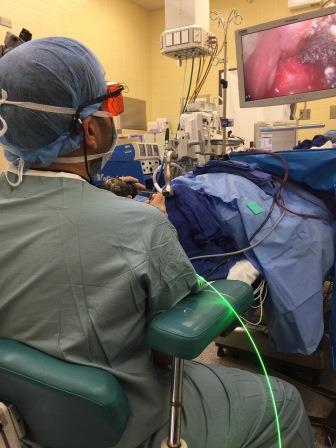LASER SURGERY for the Vocal Cords (folds)

The best way to understand a voice problem or hoarseness and develop a comprehensive treatment plan, is the proper visualization of the vocal cords (vocal folds).
At the Chicago Institute for Voice Care, (CIVC), sometimes treatment involves operating on the vocal cords; this is known as phonosurgery. Dr. Sims is specially trained in this highly delicate procedure which can improve the range and clarity of the voice. Many voice users view surgery as a last resort, but removing the problem is often the best way to get one's voice back.
One important tool for treatment of the vocal cords is a laser. LASER stands for Light Amplification by Stimulated Emission of Radiation. The laser used in vocal cord surgery doesn't produce any more radiation than you get from light bulb or a microwave. In surgical use, the laser focuses and concentrates energy so that the surgeon has a tool that can work either as a precision scalpel for very small areas of the vocal cords or as a high-tech cloth that resurfaces larger areas.
We use the red light or carbon dioxide, laser which is excellent for penetrating deeply into the cords or the green light laser which uses a compound called KTP. KTP is particularly good for vaporizing papillomas, nodules, cysts, polyps, webs, or other masses. Both types of lasers help reduce pain and blood loss by sealing blood vessels, and are known as precision instruments in the hands of a skilled surgeon. The red laser is often used in the operating room, while the green laser can be used in both OR and outpatient surgery settings. CIVC's procedures typically are performed on an outpatient basis.
Laser-guided procedures are performed with a scope that is inserted through the nose or mouth. Topical anesthesia is applied, but most patients tolerate the procedure well with little pain. There may be mild discomfort with swallowing, but most patients can eat softer foods, like soup, the same day as the procedure and resume their typical diet the next day.